4 Benefits of Cognitive behavioral therapy
Table of content
- 1. Provides people with hope regarding their condition
- 2. Supports the growth of self-esteem
- 3. Helping people unwind
- 4. Increases the use of rational thought processes
- What is Cognitive Behavioral Therapy?
- What are the benefits of CBT for anxiety?
- What are the benefits of CBT for depression?
- What are the benefits of CBT for physical addiction?
- What are the components of Cognitive behavioral therapy?
- What are the other types of Cognitive behavioral therapy?
- What are the limitations of Cognitive behavioral therapy?

Cognitive-behavioral therapy (CBT) is a type of talk therapy that focuses on identifying negative thoughts and beliefs in order to modify them into more positive alternatives. The main purpose of CBT is to act on irrational thought patterns that influence negative feelings and behaviors.
The benefits of cognitive-behavioral therapy are numerous, but the most significant advantages include providing patients with hope, supporting self-esteem, helping people unwind or relax, and supporting rational thought processes.
Despite numerous benefits, CBT has limitations too. For instance, in particular situations, the therapy is inadequate for certain patients. At the same time, it tends to be on the pricier side. Finally, cognitive-behavioral therapy has the tendency to overlook that other negative concepts are based on real experience, not irrational thoughts.
1. Provides people with hope regarding their condition
Providing people with hope regarding their condition highlights the part of CBT that not solely gives people practical skills to overcome obstacles, but additionally fosters optimism and hope for their long-term well-being.
Persons with mental health conditions often feel pessimistic or hopeless regarding their life and future. Hopelessness comes along when a person feels stuck in the state they’re in, particularly after failed attempts to get better. Persons in such a state of mind tend to feel like they’re trapped in a dark and deep hole that’s impossible to climb out of.
A 2020 paper by Fortuna et al., from the journal Social Work in Mental Health reported that hopelessness among individuals with severe mental illness is an essential but understudied aspect of health. In addition, the study found that there was a strong correlation between higher feelings of hopelessness and increased alcohol use. This creates a vicious cycle where a person feels hopeless, engages in risky behaviors, and feels more hopeless afterward.
Mental health problems, including addiction, affect one’s perspective and make it impossible to see the light at the end of the tunnel. A person can’t think ahead of time when the illness no longer impacts them. Most people assume recovery isn’t meant to happen.
One of the most prominent advantages of CBT is that it works to change a person’s perspective and provide people with hope. Cognitive-behavioral therapy helps people understand their thoughts aren’t always realistic. At times, our thinking patterns aren’t accurate and do not represent reality or what’s likely to happen.

During CBT therapy sessions, patients learn to challenge or question their thoughts. The act of challenging thoughts or beliefs gives rise to new possibilities or hopes. They are able to imagine their life beyond illness and realize it’s possible to overcome their current state and live a happier life. Cognitive-behavioral therapy enables people with mental health illnesses to feel more optimistic and believe they deserve to get better.
2. Supports the growth of self-esteem
Supporting the growth of self-esteem entails progressively developing a more accurate and balanced perspective of oneself through CBT, resulting in enhanced self-acceptance and confidence. In addition, CBT promotes a sense of achievement and self-worth by helping people establish attainable objectives and actively pursue their own development.
One of the most crucial aspects of psychological well-being is self-esteem. A paper by Peter H. Silverstone and Mahnaz Salsali published in the February 2003 issue of the Annals of General Hospital Psychiatry stated that lower self-esteem is often associated with psychiatric problems, according to an array of prior studies. For psychiatric patients, self-esteem additionally has an impact on their quality of life.
Mental health disorders associated with low self-esteem include depression, eating disorders, anxiety disorders, and substance use disorders.
The most dangerous thing about low self-esteem is that it contributes to the cycle of negative thoughts and beliefs. At the same time, negative or irrational thoughts and beliefs contribute to low self-esteem.
Negative self-esteem leads to maladjustment and escapism. A person who lacks trust in themselves becomes unable to handle daily problems. As a result, their ability to achieve their full potential is significantly reduced.
In 2004, Health Education Research published a paper by Mann et al., confirming that emphasizing self-esteem is regarded as a fundamental aspect of promoting mental well-being.
Cognitive-behavioral therapy is beneficial for persons with low self-esteem. It enables them to develop more confidence in their abilities. What makes CBT beneficial for increasing self-esteem is that it helps people understand how their thoughts work.

Cognitive-behavioral therapy is beneficial for persons with low self-esteem. It enables them to develop more confidence in their abilities. What makes CBT beneficial for increasing self-esteem is that it helps people understand how their thoughts work.
By learning to identify unrealistic thoughts and negative thinking patterns, people are able to control them. That means their whole belief system changes as well. With these changes, people notice shifts in their perspective of themselves and the world. As a result, their self-esteem increases. Patients no longer think they can’t do or achieve something, which is why their tendency to engage in harmful behavior decreases as well.
In a 2017 randomized controlled trial by Griffioen et al., published by Frontiers in Psychology, cognitive-behavioral therapy proved to be effective in increasing self-esteem.
3. Helping people unwind
Helping people unwind is a component of CBT that facilitates individuals’ relaxation is the integration of stress management strategies and relaxation techniques into the therapeutic process. CBT acknowledges the complex interrelation between mental and physical health, recognizing that heightened levels of stress and tension worsen psychological symptoms.
Stress is a major component of mental health disorders. While it’s a natural response to negative stimuli, prolonged or unmanaged stress causes various problems. Not only does it increase the risk of mental health problems, but it additionally worsens existing conditions. Stress leads to or aggravates depression, anxiety, and burnout.
Problems with stress stem from the fact it contributes to negative thinking. For a person with irrational thoughts and beliefs, this is particularly difficult. Negative thought patterns further contribute to underlying mental health disorders.
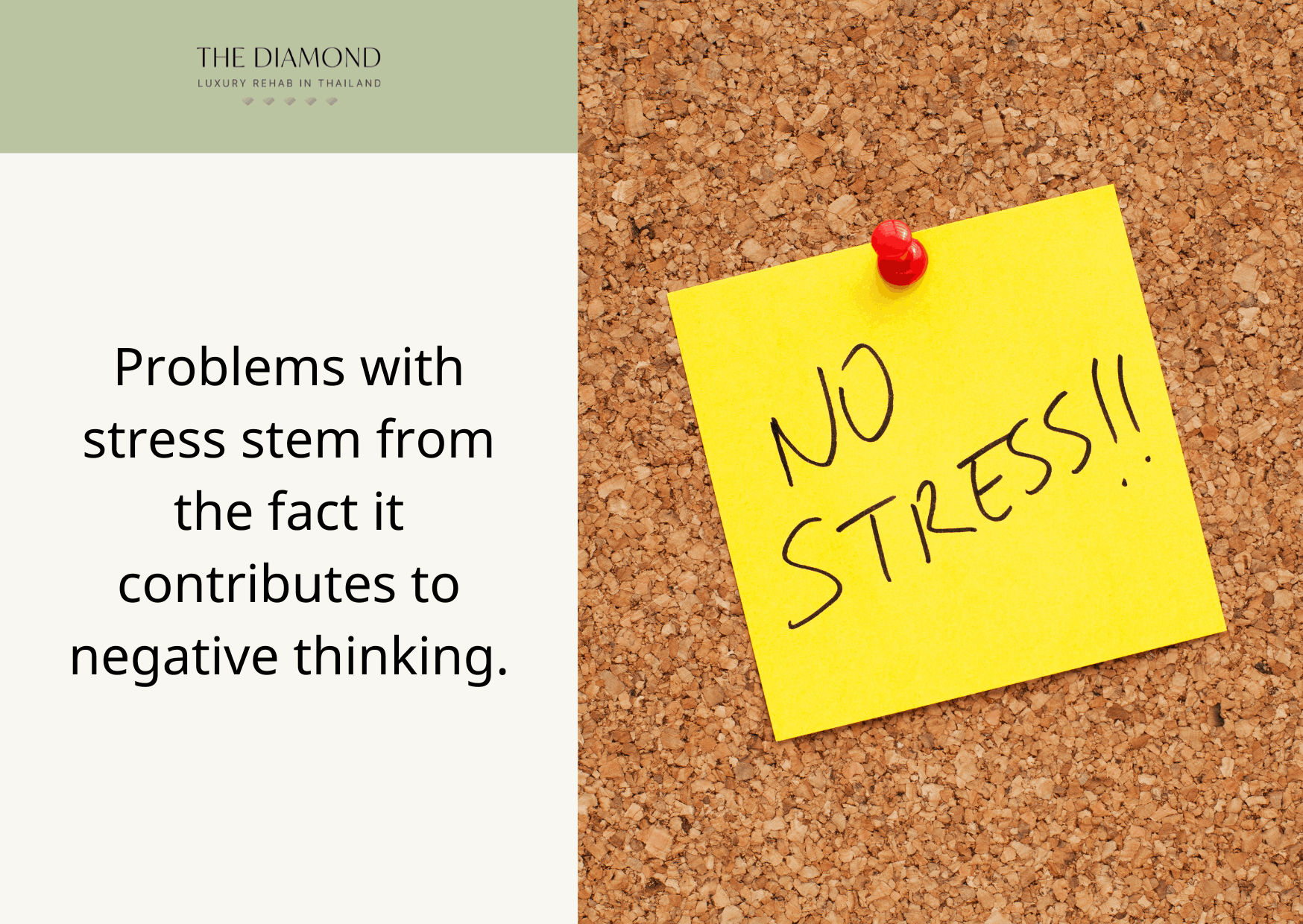
For that reason, stress management is one of the most significant aspects of treating a mental health problem. That’s where cognitive-behavioral therapy steps in. One of the many benefits of CBT is that it helps people unwind and relax.
It helps people learn to control how they respond to negative stimuli and stressful situations. When that happens, it becomes easier to respond to triggers of irrational/negative thoughts in a healthier manner. When it comes to the strengths of cognitive-behavioral therapy, it’s important to emphasize that it helps patients adopt more favorable coping mechanisms. In turn, they are able to relax and have a healthier approach to life and to their mental illness.
4. Increases the use of rational thought processes
A rational thought process is an ability to think with a reason i.e. rationally. It refers to the ability to reach sensible conclusions from logic, facts, and data. The rational thought process isn’t based on emotions but on information.
People with mental health problems usually don’t have control over their thoughts. They tend to deal with cognitive distortions. The term cognitive distortion describes an irrational or exaggerated pattern of thinking. These thoughts cause people to perceive reality inaccurately.
It is cognitive distortions that lead to negative thinking patterns and false beliefs. They worsen mental health and jeopardize recovery unless resolved properly. Cognitive-behavioral therapy helps achieve just that.
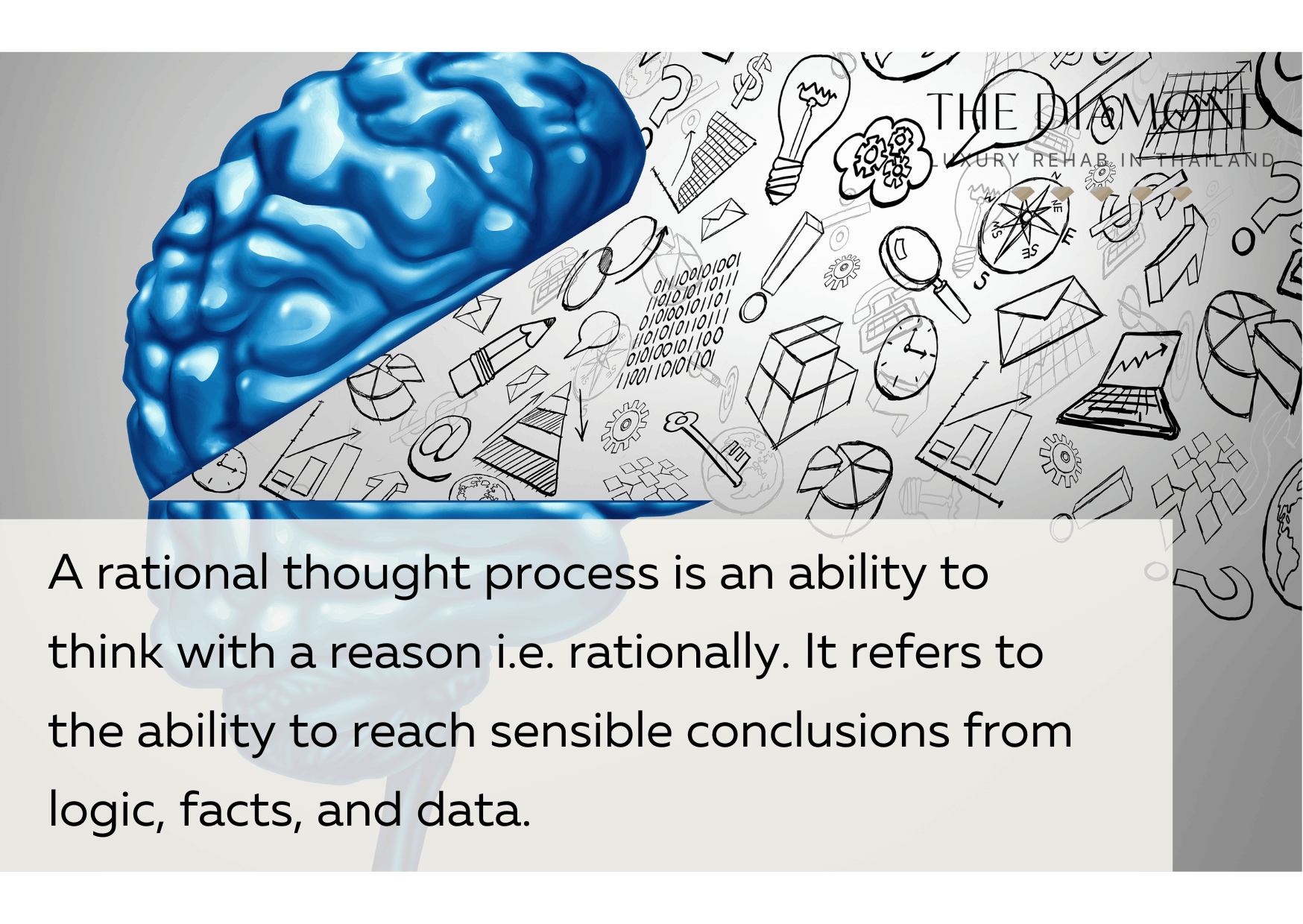
The most significant advantage of CBT is that it promotes rational thought processes and increases its use among patients. Men and women with mental health problems struggle with cognitive distortions. These irrational thoughts and beliefs tend to be persistent and stubborn, difficult to ignore or eliminate. The more people focus on these thoughts, the worse they become.
Cognitive distortions are, thereby, targeted in the management of mental health problems. The therapy teaches patients to question these beliefs. Through questioning and evaluating or analyzing cognitive distortions, people understand they’re not based on logic and reason. Instead, they come to the realization that those thoughts stem from emotions rather than logic.
All these help a person gain more control over their thinking process. It’s a major aspect of managing mental health disorders.
What is Cognitive Behavioral Therapy?
Cognitive-behavioral therapy is a type of therapy that helps people manage their problems by changing the way they think and behave. This type of talk therapy is structured and goal-oriented, and it works for the management of various mental health disorders.
Cognitive-behavioral therapy is a combination of cognitive and behavioral therapy. The latter explores what a person does, whereas the former is concerned about what they think.
The basis of both types of therapy is that healthy or positive thoughts lead to healthy behaviors and feelings. For that reason, CBT is used for the management of anxiety, depression, substance use disorders, personality disorders, and eating disorders. It additionally helps patients with schizophrenia and bipolar disorder.
Even though CBT was developed in the 1960s by Dr. Aaron T. Beck at the University of Pennsylvania, the roots of this therapy are traced to ancient times. In fact, the most significant aspects of CBT have been found in philosophical traditions such as Stoicism. According to Stoicism, we have the ability to use logic to identify and dismiss false beliefs/thoughts that lead to destructive emotions.
The main goal of cognitive-behavioral therapy is to change the automatic negative thinking that contributes to or worsens the emotional and mental health and well-being of patients. At times, CBT alone is necessary, but in certain cases, doctors recommend it in combination with other treatment approaches such as medications.
Cognitive-behavioral therapy is a hands-on approach that allows patients and therapists to collaborate on modifying patterns of behavior and thinking that are of the biggest benefit to patients’ moods and quality of life.
What are the benefits of CBT for anxiety?
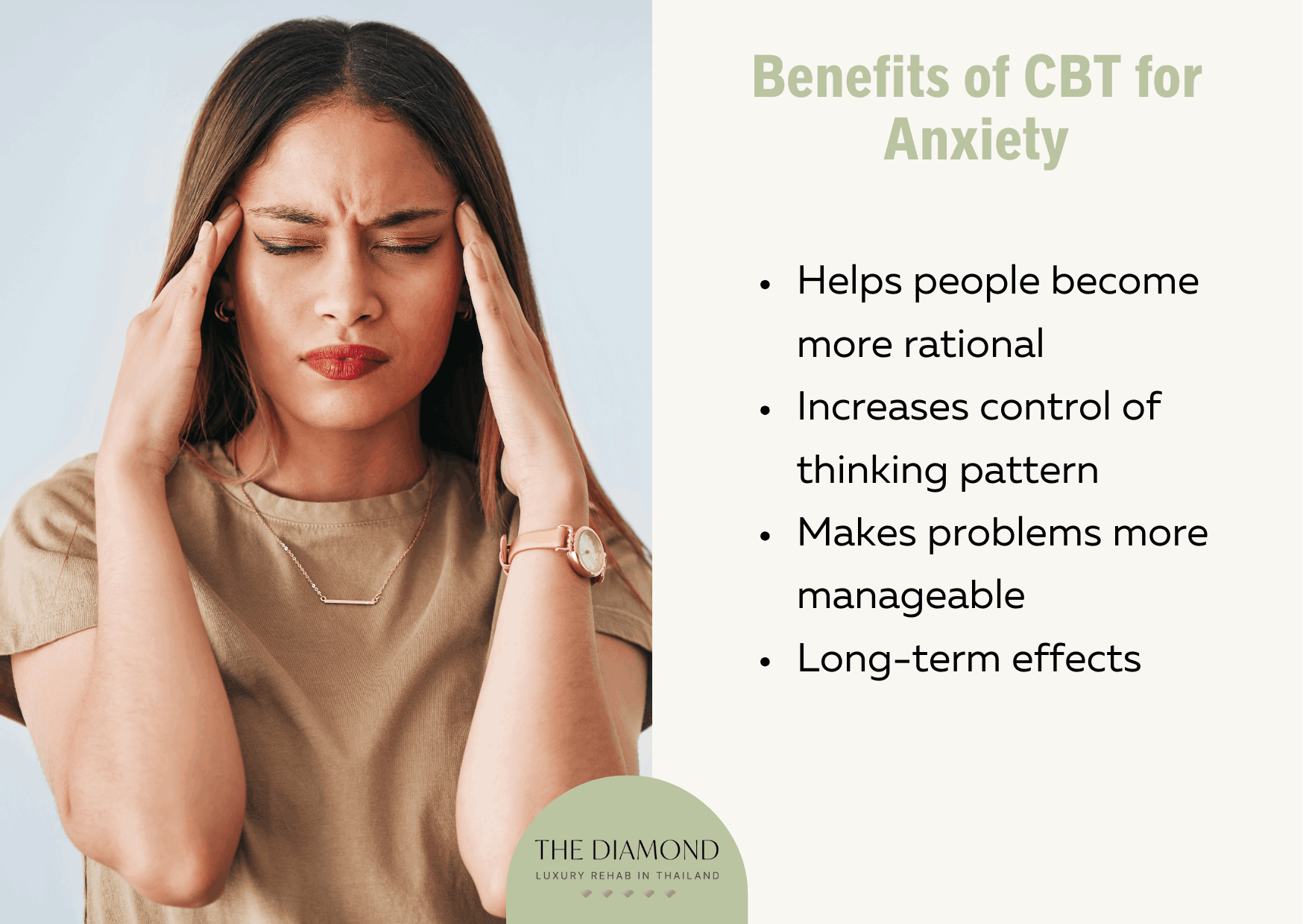
The benefits of CBT for anxiety go beyond mere alleviation of symptoms. It additionally helps those who suffer from anxiety disorders build resilience and enhance their overall quality of life as time goes on. The benefits of CBT for anxiety are listed below.
- Helps people become more rational: Anxiety disorders trigger irrational thought patterns and vice versa. Irrational thoughts, such as catastrophic thinking, interpretations of events, appraisals, and other worst-case scenarios, lead to difficulty coping. That happens because these thoughts are logically irrational and, thereby, complex to handle. The greatest problem with irrational thinking is that a person isn’t always aware of it. As a person keeps focusing on these thoughts, they become stronger and aggravate symptoms of anxiety. The main purpose of CBT is to help patients identify irrational thoughts, reach their core, and let them go. The therapist empowers a patient to acknowledge that certain thoughts and beliefs have no rational or logical foundation. This shakes the power of those thoughts and paves the way for the management of anxiety.
- Increases control of thinking pattern: Unwanted or uncontrollable thoughts are a common symptom of anxiety. Negative thoughts affect everyone, but anxiety makes it difficult or almost impossible for a person to control them. The relationship between unwanted thoughts and anxiety is a two-way street; one influences the other. Successful anxiety management calls for greater control over racing thoughts and cognitive distortions. That’s where cognitive-behavioral therapy steps in. As CBT supports rational thinking, it allows a patient with anxiety to control their cognitive distortions more effectively. They’re able to recognize irrational thinking patterns and manage them in order to prevent the worsening of anxiety symptoms.
- Makes problems more manageable: Anxiety affects the ability to solve problems in educational, professional, and social aspects of life. Fear and anxiety are among the emotions that impairs an individual’s problem-solving ability, according to a 2020 study by Korkmaz et al., published in the Journal of Clinical Neuroscience. Irrational thoughts “cloud” a person’s mind, reduce rational thinking abilities, and thereby make it difficult to devise solutions. These thoughts additionally affect decision-making. The process of decision-making takes place in the prefrontal cortex. Anxiety reduces the activity of this brain region. That way, it slows down the part of the brain that people engage in making decisions. Cognitive-behavioral therapy makes problems more manageable and thereby proves to be helpful for anxiety patients. First, CBT focuses on current problems that are troubling a patient and enables them to find solutions. At the same time, with improved rational thinking, patients find it easier to make wiser decisions and solve tasks at hand.
- Long-term effects: Tackling irrational thoughts and beliefs requires a long-term commitment or a treatment whose results are long-term. This is yet another advantage of cognitive-behavioral therapy for patients with anxiety. Studies show CBT yields long-term results. For instance, results of a 2019 study by von Brachel et al., from Psychotherapy and Psychosomatics indicated that CBT has long-term efficacy under regular circumstances for a diverse range of issues, particularly when contrasted with the enduring effects of medical interventions. Furthermore, in 2020, JAMA Psychiatry published a study titled, “Long-term Outcomes of Cognitive Behavioral Therapy for Anxiety-Related Disorders,” which demonstrated that within a year after completing treatment, CBT was linked to reduced anxiety symptoms. Cognitive-behavioral therapy provides long-term results because it empowers a person to take control of their thought processes and makes them more resilient to cognitive distortions.
What are the benefits of CBT for depression?

The benefits of CBT for depression are listed below.
- Promotes stress management: Stress wreaks havoc on mental health, while chronic stress increases the incidence of depression. The relationship between stress and depression is bidirectional in a way that one can cause or worsen the other. Chronic or severe stress impairs the equilibrium of the psyche. Fortunately, cognitive behavioral therapy focused on stress management proves to be effective. It works through increased mindfulness and rationalization of the thinking process. Reducing stress levels can help manage depression.
- Reduces the intensity of depression symptoms: The intensity of depression symptoms ranges from mild to severe. Various factors influence the severity of these symptoms, including stress, co-occurring mental health disorder, and life circumstances. One of several goals of depression management is to work on reducing the intensity of the symptoms that people experience. Cognitive behavioral therapy can make it happen. It works by helping a patient identify negative thoughts or beliefs that feed their depression and its symptoms. Then, a person starts working on dismantling those beliefs, which leads to reduced severity of symptoms that patients experience
- Gives a new perspective on problems: Depression can alter information processing in the brain. It changes a person’s perspective of their life and the world around them. Negative thoughts have too much power, which leads to feelings of hopelessness, helplessness, and worthlessness. A person with depression sees no way out of their situation or they believe a certain issue has no solution. An important benefit of cognitive behavioral therapy for persons with depression is that it gives them a new perspective. Again, it works through increased rational thinking processes. By challenging negative beliefs, a person starts thinking more rationally and begins to draw conclusions based on logic. This allows them to change their perspective on solving some problems, their own life, and the world around them.
- Increases happiness and life satisfaction: Depression steals joy, happiness, and passion for life. Men and women with depression tend to struggle with the loss of interest in life and activities they used to enjoy or that made them happy. That said, a study from the Asian Journal of Psychiatry found that cognitive behavioral therapy leads to significant enhancement of life satisfaction, life orientation, and family functioning. It is the very irrational thinking that makes depression suck happiness out of someone’s life. As therapy targets those thought patterns, it helps a person regain their happiness back.
- Reduces risk of suicidal thoughts and tendencies: the most severe symptoms of depression are suicidal thoughts and tendencies. While most people with depression experience symptoms such as helplessness and hopelessness, in some patients, these feelings are extreme. They see no solution to their problems, believe they are not good enough and are convinced the only way to get out of the situation is through suicide. Some people have suicidal thoughts only, but others go a step further and actually try to find ways to do it. Cognitive behavioral therapy helps reduce the risk of this severe scenario. A paper from Psychology Research and Behavior Management explained that cognitive behavioral therapy is a useful strategy for the prevention of suicidal cognitions and behaviors. It works by decreasing symptoms that are linked to a higher risk of suicide. So, by reducing the intensity of depression symptoms (as mentioned above), CBT can decrease the likelihood of suicidal ideation.
What are the benefits of CBT for physical addiction?

The benefits of CBT for physical addiction are multifaceted and crucial in aiding individuals in overcoming their dependence on substances or behaviors. The benefits of CBT for physical addiction are listed below.
- Helps identify triggers for substance abuse: A trigger is any environmental or emotional factor that increases cravings for addictive substances and makes a person want to use them. Exposure to triggers without effective coping techniques worsen addiction and lead to more serious complications. Cognitive-behavioral therapy helps identify triggers and deal with them accordingly. Triggers are often irrational thoughts or impaired perception of reality. This type of talk therapy helps deal with triggers in three ways such as to recognize, avoid, and cope. Recognize which situations or circumstances lead to substance abuse. Avoid those situations whenever possible. Finally, use CBT techniques to cope with emotions caused by those triggers.
- Reduces cravings: The biggest reason people relapse when attempting to recover from physical addiction is craving for the substance. Cravings happen because the body and brain, which got used to the presence of the substance, start asking for it, believing they need it. Moreover, addictive substances act on dopamine and produce feelings of pleasure. With continued use, dopamine receptors weaken, meaning higher amounts of the substance are necessary for the same effects. That leads to higher cravings for drugs or alcohol, dependence, and addiction. Cognitive-behavioral therapy helps persons with physical addiction reduce their cravings. Its mechanism of action is simple here; the focus is to help a person avoid succumbing to those cravings. Cravings appear as irrational thoughts that pressure a person to take the substance. CBT empowers a person to recognize those thoughts, challenge them, understand they don’t need the drug, and remain resilient. This lessens the power of the cravings in physical addiction.
- Prevents relapse: Various factors lead to relapse, including high-stress levels and unrealistic expectations of addiction recovery. Relapse isn’t the end of the road, and it doesn’t indicate that recovery is impossible. Instead, relapse is an opportunity to identify strengths and weaknesses to work on. Cognitive-behavioral therapy helps prevent relapse by lowering stress levels, supporting rational thinking, and decreasing cravings. It additionally teaches patients skills and techniques they’re able to use to support their recovery.
- Increases confidence: Low self-esteem or confidence contributes to addiction and jeopardizes a person’s recovery. Cognitive-behavioral therapy teaches patients with physical addictions to increase their confidence by recognizing the link between their thoughts, feelings, and behaviors. According to CBT, it’s not about what we experience but how we interpret situations or events that determine how we are. Instead of interpreting certain situations or stimuli in an irrational or negative manner, CBT teaches patients to base their decisions on logic and reason, which leads to higher confidence.
- Offers new behavior strategies: Irrational thoughts and beliefs lead to negative feelings, which culminates in negative or risky behaviors such as addiction to various substances. Cognitive-behavioral therapy offers new strategies that patients use to improve their behaviors. It works by correcting their cognitive distortions and thought processes. Through healthier thinking patterns, people improve their feelings or emotions, which leads to positive changes in their behaviors. Furthermore, cognitive-behavioral therapy teaches coping mechanisms and ensures patients know how to act in different situations. In other words, CBT teaches people useful strategies to modify their behaviors and prevent them from reacting out of proportion to reality. All this helps a person with physical addiction because they get to control their reactions to things around them.
How does Cognitive behavior therapy work?
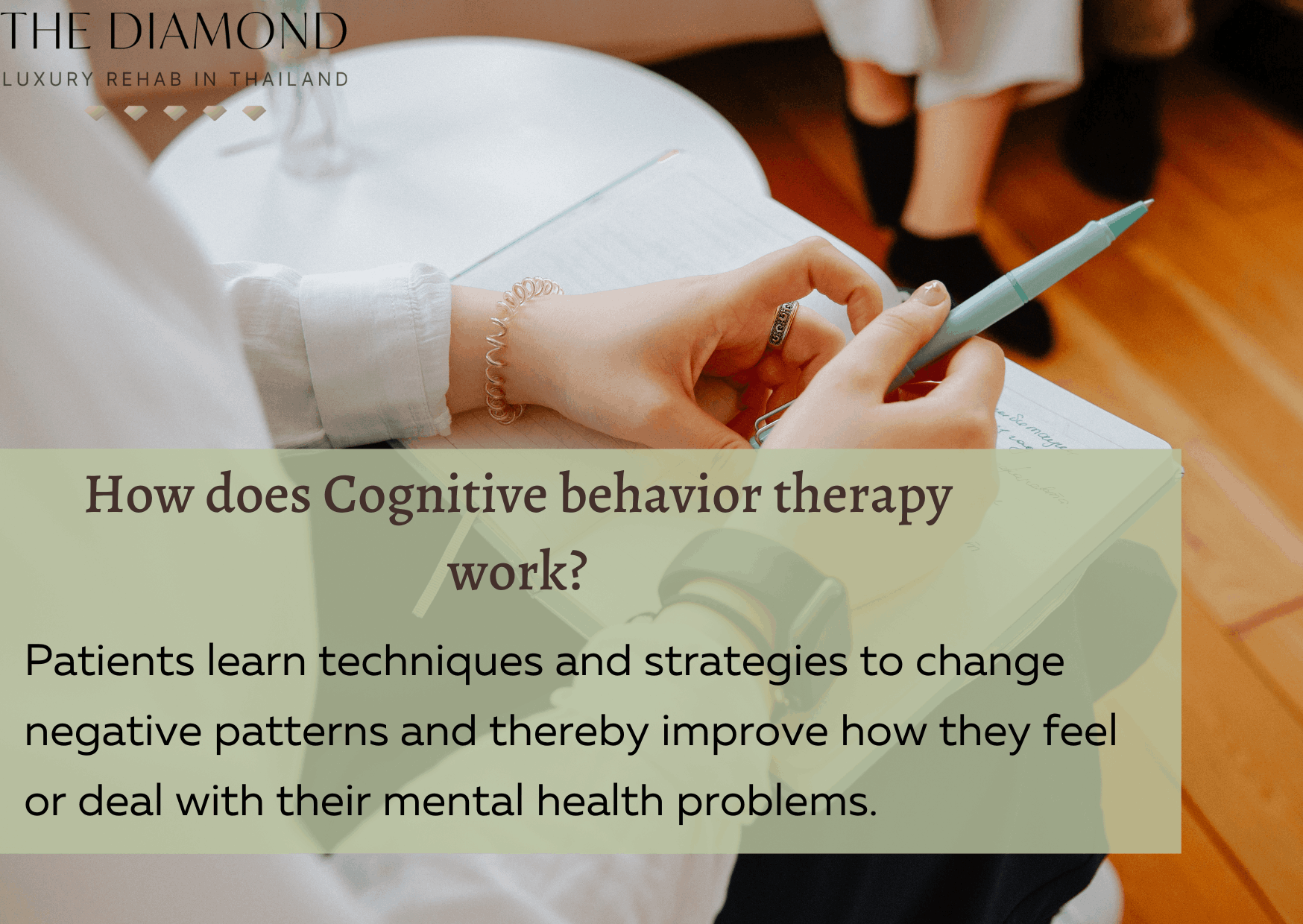
Cognitive behavior therapy works in a relatively simple mechanism of action. As an article titled, “Overview – Cognitive behavioural therapy (CBT) last reviewed in November 2022 by the UK’s National Health Service explained, the idea that our thoughts, feelings, behaviors, and bodily sensations are interconnected is the foundation of cognitive-behavioral therapy. Irrational or negative thinking creates unpleasant emotions, which keep a person stuck in a vicious cycle.
Cognitive distortions lead to an unhelpful mindset, jumping to conclusions, mistakenly seeing situations as catastrophic, and seeing things as solely good or bad with nothing in between. When left unmanaged, this way of thinking happens automatically. However, cognitive-behavioral therapy challenges these automatic thoughts and encourages patients to compare them to reality.
What cognitive-behavioral therapy does is help people handle overwhelming problems in a more positive manner. It works by breaking down those problems into smaller elements. Patients learn techniques and strategies to change negative patterns and thereby improve how they feel or deal with their mental health problems.
Unlike some other forms of therapy, CBT is concerned with present i.e. current problems. It is a practical therapy to improve a person’s state of mind. When a person starts viewing a specific situation in a more helpful manner, their distress reduces. They’re able to use that mindset to make healthier and wiser choices.When it comes to the subject of how CBT works, it’s useful to keep in mind that in order to help patients overcome their mental health disorders, therapists use various CBT techniques, including cognitive restructuring/reframing, role-playing, exposure therapy, journaling, meditation, and progressive muscle relaxation. Other techniques include goal-setting, problem-solving, positive activities, systematic desensitization, and homework.
What are the components of Cognitive behavioral therapy?
The components of cognitive-behavioral therapy are cognitive therapy, behavioral therapy, and mindfulness-based therapy.
The main focus of cognitive therapy is on thought patterns, which are considered responsible for negative emotions and behaviors. Cognitive therapy teaches that negative emotional states are produced and maintained by exaggerated or ineffective biases in thinking.
For that reason, cognitive therapy works to identify self-destructive thoughts or beliefs and teaches a patient to respond to them in a more rational manner. This leads to fewer emotional problems and more successful behaviors.
Behavioral therapy, on the other hand, focuses on behaviors and considers them a more significant component of problematic psychological patterns. This type of therapy prioritizes analyzing problems to identify problematic behaviors, which are then replaced with more favorable alternatives.
Mindfulness-based therapy is a relatively new component of CBT. It emphasizes sustained attention to the present.At the same time, components of cognitive-behavioral therapy include thoughts (cognitions), emotions (feelings), behaviors, and a person’s biology (physiology). Cognitive-behavioral therapy teaches that if a person has the ability to identify and understand these four components and how they interact, they are better able to explain and solve their problems.
What are the other types of Cognitive behavioral therapy?
Other types of cognitive behavioral therapy are demonstrated in the table below.
| Type of CBT | Developed in | Characteristics | Best for |
| Dialectical behavior therapy (DBT) | 1970s by Dr. Marsha Linehan at the University of Washington when she and her team discovered that classic CBT isn’t enough for some patients | Specifically created for people who feel their emotions intensely It was initially used for the treatment of patients with borderline personality disorderHelps people understand and accept difficult feelings, learn skills to manage them, and make positive changes in life | Self-harming Depression Suicidal ideation Borderline personality disorder Bipolar disorder Post traumatic stress disorder (PTSD)Substance use disorders Eating disorders ADHD |
| Acceptance and commitment therapy (ACT) | 1982 by Steven Hayes, an American psychologist, in order to develop an approach that integrates both key features of cognitive and behavior therapy | Emphasizes acceptance as a way of dealing with negative thoughtsTeaches patients to stop denying their inner emotionsHelps patients acknowledge deeper feelings without judgment and commit to healing | Depression Obsessive-compulsive disorders (OCD) PTSD Workplace-related stress Substance abuse Chronic pain Psychosis |
| Rational Emotive Behavior Therapy (REBT) | 1950s by Dr. Albert Ellis, American psychotherapist and psychologist, after losing hope in the power and effectiveness of psychotherapy | Helps identify irrational beliefs and negative thoughts that lead to emotional/behavioral issuesBelieves in Unconditional Self Acceptance wherein a person should think of themselves highly no matter what | Depression Anxiety Guilt Procrastination Aggression Eating disorders Extreme or inappropriate anger |
| Multimodal therapy | 1960s by South African psychologist Arnold Lazarus after noticing his patients could benefit from multiple therapy types at once | Intended to optimize the treatment of mental health disorders by delivering multiple types of therapy togetherMay include DBT, ACT, REBT, cognitive therapy, behavior therapy, and others | Anxiety Depression Schizophrenia Personality disorders Attention-deficit hyperactivity disorder (ADHD) Bipolar disorder Autism spectrum disorders Eating disorders Substance use disorders Psychotic symptoms |
How long does it take for the effects of CBT to begin?
The time it takes for the effects of CBT to begin varies from patient to patient, as certain individuals experience marked improvement within a few sessions, whereas others require treatment to span several months, according to a topic titled, “Cognitive behavioral therapy” last updated in September 2016 by the Institute for Quality and Efficiency in Health Care (IQWiG).
Standard CBT treatment requires weekly sessions for 12 to 20 weeks, a 2018 article titled, “Intensive CBT: How fast can I get better?” from Harvard Health explained. The sessions last between 30 and 60 minutes. Certain patients potentially need more than that to experience the effects and achieve the full potential of CBT.
However, there is another option called intensive CBT (I-CBT) which uses significantly longer sessions condensed into one or more weekends, weeks, or months, or occasionally into a single eight-hour session.
In the beginning, patients attend 60-minute sessions once or twice a week. As they keep making progress, sessions drop to 30-45 minutes once a week or every two weeks. The therapist is the one who determines the length of sessions based on the unique needs and progress of each patient. How long it takes for the effects of CBT to begin additionally depends on several factors. These factors include the type and severity of mental health disorder, presence of comorbidities, adherence to therapy, and patient engagement. The onset of effects of CBT is different for each patient since everyone’s different.
What are the limitations of Cognitive behavioral therapy?
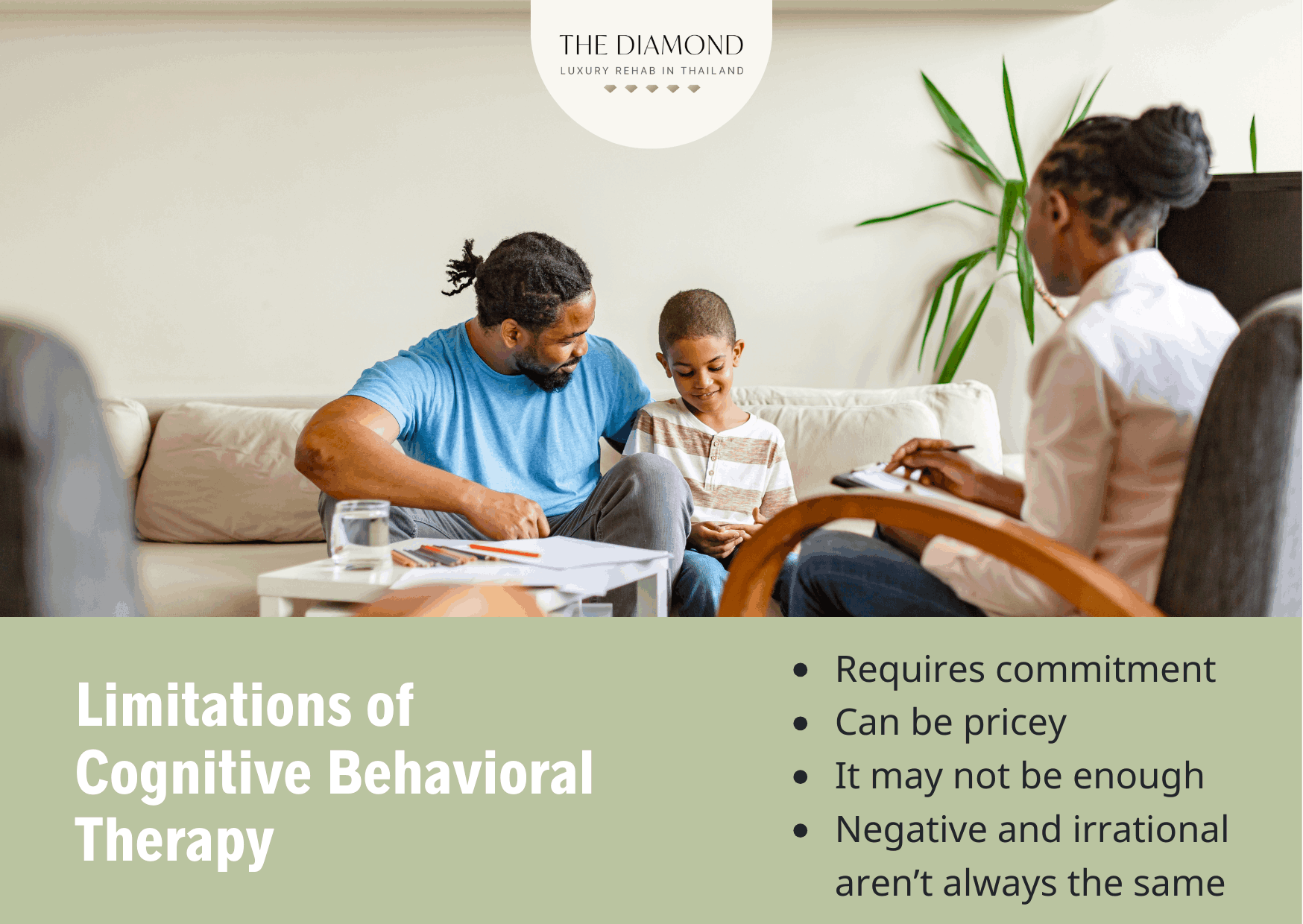
The limitations of cognitive behavioral therapy are listed below.
- Requires commitment: Although CBT treatment is relatively short-term, it still requires a great deal of commitment and persistence to get desired effects. For some individuals, it can be particularly difficult to commit (but not impossible), which is why this point is among CBT limitations.
- Can be pricey: The costs of cognitive behavioral therapy may vary from one place to another or based on insurance coverage. In some cases, it can be on the more expensive side. The good thing, though, is that many therapists offer sliding scale fees to make it easier for their patients to cover the costs.
- It may not be enough: While most patients can benefit from CBT alone, some do not. This is particularly the case for persons with more complex or intense health concerns. In these cases, CBT is accompanied by medications or other forms of therapy.
- Negative and irrational aren’t always the same: Cognitive behavioral therapy puts negative conceptions on the same shelf as irrational beliefs about oneself. They are not necessarily the same, though. If a patient has undergone abuse in childhood and their experience contributed to a mental health problem, later on, their negative self-conceptions aren’t irrational. They stem from real experience. In these cases, common CBT techniques may not resolve the underlying problem. It’s down to the therapist and the approach they utilize.
Is Cognitive behavioral therapy the most effective therapy?
Yes, cognitive-behavioral therapy is the most effective therapy available at the moment. A 2018 paper by David et al., from Frontiers in Psychiatry reported that cognitive-behavioral is the prevailing approach recommended by worldwide guidelines for psychosocial treatments. It is considered the primary therapy option for numerous diseases. For that reason, cognitive-behavioral therapy is considered the gold standard in the field of psychotherapy.
Furthermore, a study by David F. Tolin published in the August 2010 issue of the journal Clinical Psychology Review found that in patients afflicted with anxiety or depression, the superiority of CBT over alternative treatments was apparent. Lastly, Cognitive Therapy and Research published a 2012 review by Hofmann et al., that showed that CBT exhibited higher response rates than other forms of therapy. However, scientists emphasized the importance of further research on this subject and for long-term impact.

